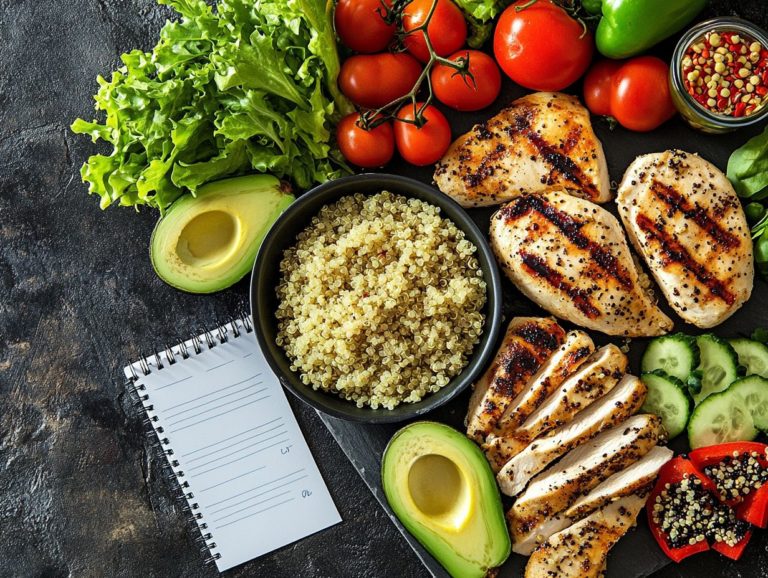How to Adjust Meal Plans for Allergies
Food allergies are on the rise. They can greatly affect what you eat and your daily life, influencing everything from meal planning to social gatherings.
It s essential to understand various allergens, recognize their symptoms, and adjust your diet accordingly to manage these allergies effectively. Dive into this article to discover common food allergens and how to tackle them! You’ll find tips for meal substitutions and strategies for communicating your dietary needs to friends, family, and restaurants.
You’ll also learn how to navigate social situations while prioritizing your health. Equip yourself with the knowledge to manage food allergies with confidence!
Contents
- Key Takeaways:
- Understanding Food Allergies
- Identifying Food Allergies
- Adjusting Meal Plans for Food Allergies
- Frequently Asked Questions
- What are common food allergies that may require adjustments in meal plans?
- How can I determine which foods to avoid when adjusting meal plans for allergies?
- Can meal plans be adjusted for multiple allergies?
- What are some common substitutions for allergenic ingredients in meal plans?
- Are there any resources available to help with adjusting meal plans for allergies?
- What steps should I take when dining out with food allergies?
Key Takeaways:

- Be aware of common allergens and their effects to better understand and identify potential food allergies.
- Look for signs and symptoms of food allergies to properly identify and manage them.
- When adjusting meal plans for allergies, consider substituting ingredients and utilize meal planning tips to ensure safe and enjoyable meals.
Understanding Food Allergies
Understanding food allergies is essential for anyone looking to maintain a healthy eating routine. These conditions can significantly impact your nutrition and overall well-being.
Food allergies typically arise from certain proteins in foods that provoke immune responses, resulting in a range of symptoms. You might also encounter food sensitivities and intolerances, which complicate meal planning and food preparation.
Working with a registered dietitian can provide personalized dietary guidelines to help you navigate these challenges.
Common Allergens and Their Effects
Common allergens like gluten, dairy, nuts, and shellfish can trigger severe reactions in those affected. Allergen-free meals are essential, and carefully identifying food triggers should be a top priority.
These substances can lead to various physiological responses, including digestive disturbances, skin irritations, and respiratory issues, all of which can significantly impact your daily life.
Understanding where these allergens come from is crucial. For example, gluten is commonly found in wheat products, while dairy lurks in many processed foods.
By recognizing these triggers, you not only protect yourself from potential health risks but also enhance your meal planning.
Exploring allergen-free meal options allows you to create delicious dishes that cater to your dietary restrictions while ensuring a satisfying and safe dining experience.
Identifying Food Allergies
Identifying food allergies requires keen awareness of the signs and symptoms that may arise after consuming certain foods. These reactions can vary significantly, from mild discomfort to severe responses, making it essential to adopt a systematic approach to monitoring your diet.
This might involve considering an elimination diet to pinpoint the specific triggers that affect your well-being.
Signs and Symptoms

The signs and symptoms of food allergies can vary significantly. They often manifest as itching, swelling, gastrointestinal distress, and respiratory issues. These symptoms can overlap with food intolerances, making it essential to recognize your food triggers.
While both allergies and intolerances can lead to stomach cramps and nausea, food allergies usually provoke more severe reactions, including anaphylaxis a life-threatening allergic reaction. In contrast, intolerances typically result in more chronic digestive discomfort.
Pay close attention to how your body reacts after eating, meticulously noting any patterns or recurring symptoms. This careful observation becomes particularly crucial when planning your meals, as avoiding specific allergens is vital to prevent adverse reactions.
Keeping a detailed food diary can help identify which items may pose a problem, ensuring a safer and more enjoyable dining experience.
Adjusting Meal Plans for Food Allergies
Adjusting meal plans for food allergies requires meticulous planning and thoughtful dietary modifications. For those with specific requirements, meal planning for special dietary needs is essential to ensure that each meal is not only safe but also nutritious.
This process demands creativity in cooking, as you’ll need to make substitutions to exclude allergenic ingredients while maintaining delightful flavors and visual appeal.
Start your journey to safer meals today your health depends on it!
Substituting Ingredients
Substituting ingredients in recipes is crucial for crafting allergen-free meals. This enables you to enjoy delicious dishes without compromising your health.
By thoughtfully swapping out certain components, you can transform traditional recipes into safe alternatives while preserving flavor and nutrition.
For instance, almond flour can replace wheat flour in baked goods for those with gluten sensitivities. It creates a delightful texture and taste.
For creamy sauces or soups, use coconut or oat milk instead of cow’s milk. This is perfect for accommodating lactose-intolerant individuals.
If a recipe calls for eggs, try applesauce or a mixture of flaxseed and water as a binding agent. This ensures your finished product remains cohesive and satisfying.
These simple modifications open the door to a world of allergen-free cooking possibilities. You can savor your favorite meals without worry.
Meal Planning Tips and Tricks
Meal planning tips and tricks can significantly elevate your experience managing food allergies. They allow you to streamline meal prep while ensuring you meet your nutritional needs.
Adopt a structured approach to craft a grocery list that highlights safe food options and aligns with essential dietary guidelines. Start by assessing your dietary restrictions to minimize risks while shopping.
Keeping a food diary is very helpful for monitoring your intake and identifying any potential reactions to new foods.
Try batch cooking! It s a fun and smart way to enjoy quick meals throughout the week. This way, you can savor a variety of nutritious meals without stress.
Communicating Allergies to Others

Communicating your allergies to those around you friends, family, or restaurant staff is crucial for ensuring safe dining experiences.
It s not just a matter of preference; it s about preventing exposure to food triggers that could lead to serious allergic reactions.
Informing Friends, Family, and Restaurants
Informing friends, family, and restaurant staff about food allergies requires clear communication and education. This ensures that meals are prepared safely and tailored to your specific dietary needs.
Use concise and relevant phrases to convey the seriousness of the situation. Mention terms like “cross-contamination (when allergens mix with safe foods)” or “food sensitivities” to help others grasp the risks involved.
When dining out, ask questions about ingredient lists and food preparation methods. Phrases like, “Could you please confirm if this dish contains any nuts?” can clarify uncertainties.
Maintain an open dialogue about food allergies. It enhances awareness and promotes safe eating experiences, encouraging restaurants to accommodate dietary restrictions more effectively.
Managing Food Allergies in Social Settings
Managing food allergies in social settings like parties and events calls for careful planning and awareness.
Understand how to navigate potential risks so you can relish social interactions without a hitch.
Navigating parties, events, and travel with food allergies requires careful planning and awareness of potential allergenic foods that could be present.
Packing safe snacks can be a game-changer. Bring a variety of allergen-free options to enjoy throughout the event, reducing anxiety about unintentional exposure.
Openly communicate with your hosts about your food allergies before gatherings. This sets clear expectations and fosters a supportive atmosphere.
When dining out, research restaurants in advance to aid in menu selection. This ensures your safety is prioritized, allowing for a relaxed outing with friends and family.
Frequently Asked Questions

What are common food allergies that may require adjustments in meal plans?
Common food allergies include dairy, wheat, soy, eggs, peanuts, tree nuts, fish, and shellfish. Learning how to adjust your meal plan for fitness goals can help you avoid these allergens.
How can I determine which foods to avoid when adjusting meal plans for allergies?
Consult a healthcare professional to identify specific allergies. They can guide you on reading food labels and spotting potential allergens.
Can meal plans be adjusted for multiple allergies?
Yes, you can adjust meal plans for multiple allergies. With a bit of planning, you can learn how to plan for special dietary needs and create tasty and nutritious meals that cater to all your requirements.
What are some common substitutions for allergenic ingredients in meal plans?
There are many great alternatives! Use almond or soy milk in place of dairy milk, gluten-free pasta instead of wheat pasta, and flax eggs as a substitute for chicken eggs.
Are there any resources available to help with adjusting meal plans for allergies?
Absolutely! You can find online recipes and meal planning tools that filter out allergens. Consulting a registered dietitian or joining support groups can also provide valuable tips and ideas.
What steps should I take when dining out with food allergies?
When dining out, clearly communicate your allergies to the server and inquire about ingredients. Research the restaurant’s menu ahead of time and have a backup plan, like bringing safe snacks or eating beforehand.






